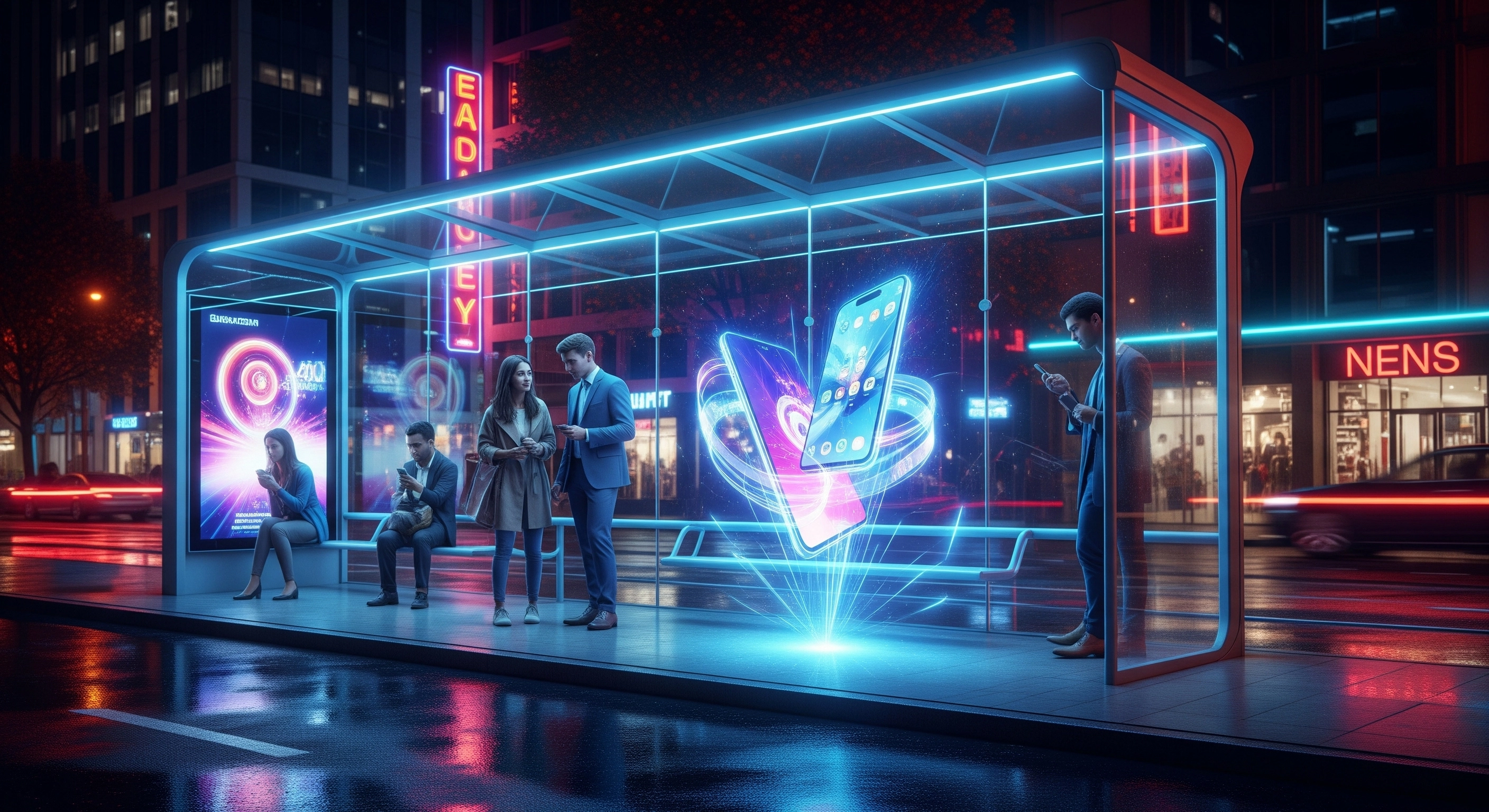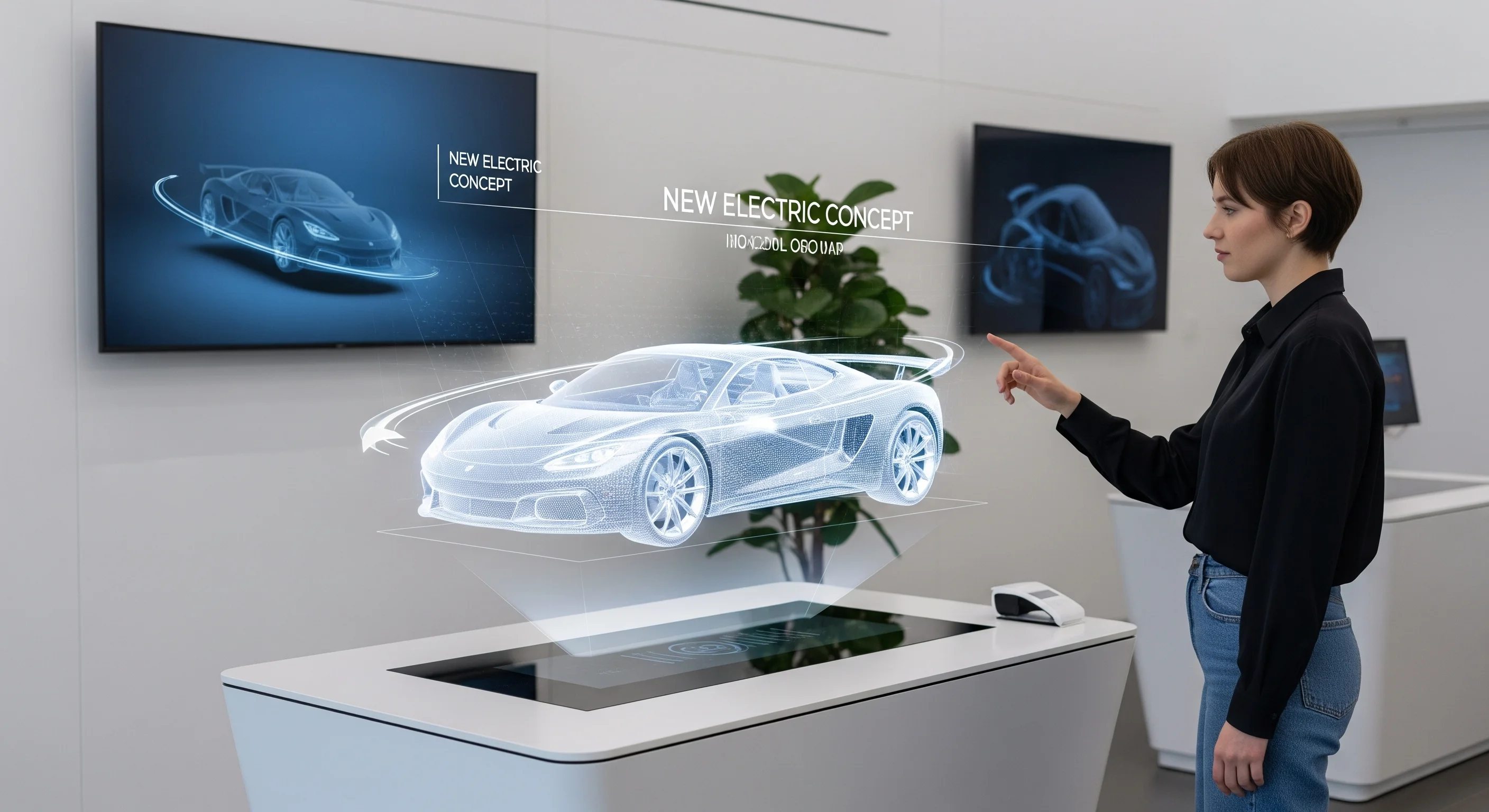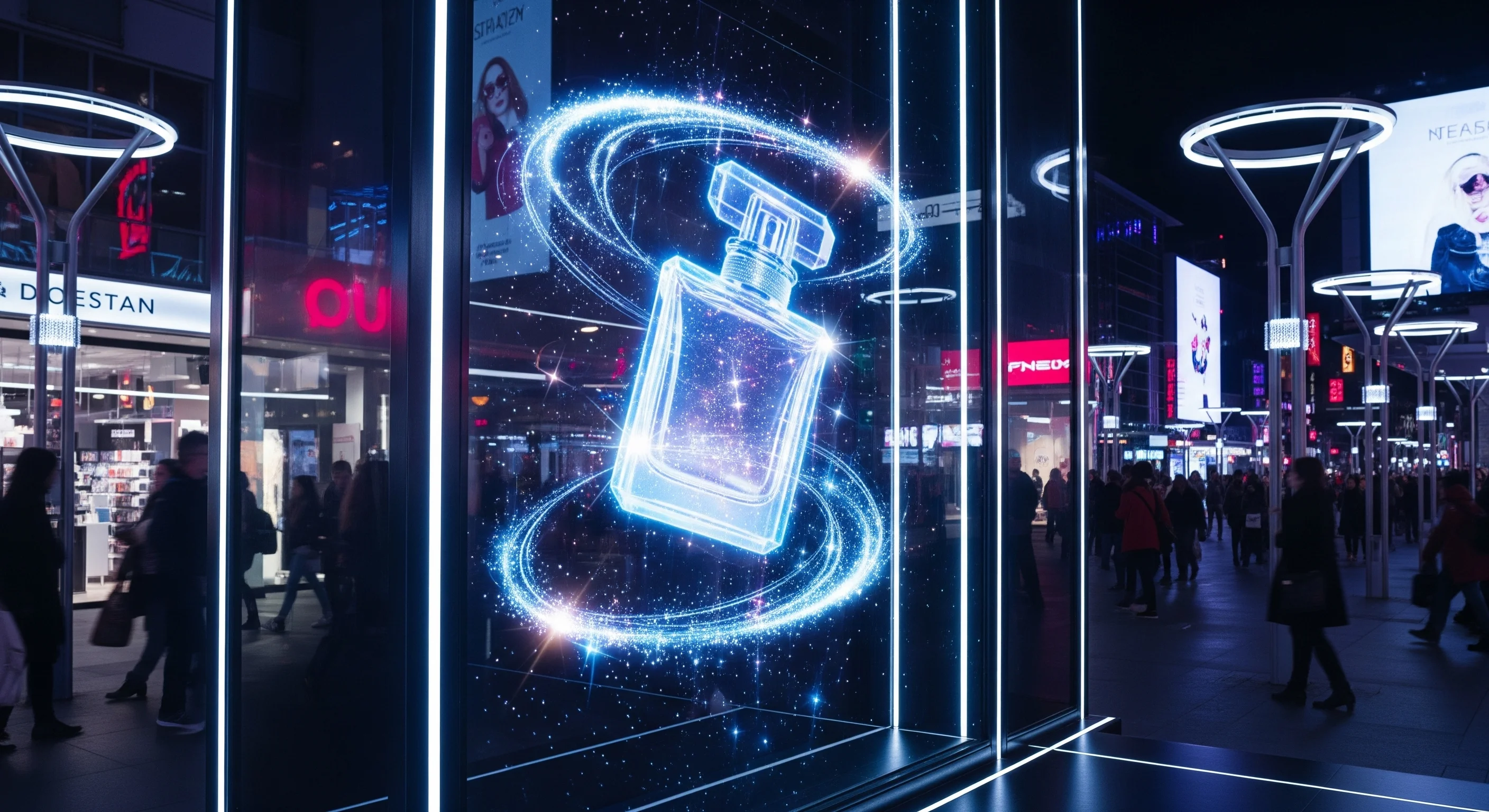What is DOOH?
Outdoor digital advertising, known by the acronym DOOH (Digital Out-Of-Home), represents a modern and dynamic form of advertising communication that uses digital screens to broadcast messages to consumers in public places. Unlike traditional billboards, DOOH integrates interactive and visual elements that capture the attention of passers-by in an effective and engaging way. These screens or holograms can be located in shopping centers, airports, train stations, busy streets, and even inside public transport.
DOOH is distinguished by its ability to display content in real time, allowing advertisers to adapt their messages according to the time of day, weather conditions, or local events. This flexibility offers brands an unprecedented opportunity to personalize their campaigns and maximize their impact. In addition, thanks to geolocation technology, ads can be targeted in a very precise way, reaching the right audience at the right time and in the right place.
Furthermore, DOOH is not just limited to advertising displays. It may include interactive elements such as touch screens, Holograms, QR codes, and even integrations with social networks, thus allowing direct interaction between the brand and consumers. This interactive dimension transforms advertising into an immersive and memorable user experience, thus strengthening brand engagement and loyalty.

The evolution of outdoor advertising
Outdoor advertising has come a long way from simple static paper billboards. In its early days, ads were mostly printed posters stuck to panels or walls, often limited by their static nature and their inability to capture the attention of passers-by beyond mere sight. With the advent of digital technologies, this form of advertising has undergone a radical transformation.
Early forms of digital outdoor advertising used LED screens to display more dynamic and visually appealing messages. These screens made it possible to broadcast videos and animations, making the ads much more engaging. However, these first iterations were still limited by the technology of the time, especially in terms of resolution and ability to interact.
Today, DOOH has reached a new level with advanced technologies such as artificial intelligence, augmented reality, and IoT (Internet of Things) connectivity. These innovations not only make it possible to deliver high-quality content, but also to interact with consumers in a more sophisticated way. For example, smart cameras can analyze the flow of passers-by and adjust content based on demographics gathered in real time. This continued evolution shows that DOOH is not only an extension of traditional outdoor advertising, but a true revolution that is redefining the boundaries of what advertising can achieve.
Advantages of DOOH compared to traditional advertising
DOOH has a number of advantages over traditional forms of outdoor advertising. First of all, the ability to broadcast dynamic and interactive content makes it possible to capture the attention of passers-by in a much more effective way than a simple static poster. Digital screens, thanks to their brightness and their ability to display videos and animations, are much more visible and memorable, which considerably increases the impact of advertising campaigns.
Another major advantage of DOOH is the flexibility it offers in terms of personalizing messages. Unlike printed posters, which require time to produce and set up, DOOH content can be modified in real time. This allows advertisers to respond quickly to current events, adjust their messages based on weather conditions, or launch special promotions at specific times. This agility is particularly valuable in a marketing environment where responsiveness is essential.
In addition, DOOH offers much more precise targeting possibilities thanks to the use of geolocation data and technologies. Advertisers can deliver specific messages to targeted audiences based on their location, behavior, and preferences. For example, a clothing brand may display different ads in residential neighborhoods and commercial areas, adapting content based on the profile of passers-by. This ability to personalize messages not only increases the relevance of campaigns, but also their overall effectiveness.
How does DOOH work?
The way DOOH works is based on a combination of advanced technologies and content delivery strategies. It all starts with the installation of digital screens in strategic locations. These screens can vary in size and resolution, ranging from small touch screens in retail outlets to gigantic LED panels in stadiums or on building facades. The screens are connected to a centralized network that allows content to be managed and delivered in a synchronized and coordinated manner.
Once the screens are in place, advertising content is created and programmed using specialized software. These platforms allow advertisers to design dynamic campaigns that include videos, animations, and interactive elements. Content can be scheduled to be broadcast at specific times of the day, based on predefined criteria such as the number of passers-by, weather, or local events. This flexible programming ensures that messages are always relevant and adapted to the context.
Data collection and analysis also play a crucial role in the functioning of DOOH. Sensors and cameras can be integrated into screens to gather information about the behavior of bystanders, such as the number of views, interaction time, and even demographic characteristics. This data is then analyzed to optimize campaigns in real time. For example, if an ad is particularly attracting the attention of a certain age group, advertisers can adjust their strategy to target that segment more closely. This intelligent use of data makes it possible to maximize the effectiveness and return on investment of DOOH campaigns.
Targeting and personalization in DOOH
One of the major advantages of DOOH lies in its targeting and personalization capabilities. Unlike traditional outdoor advertising methods, which broadcast a single message to a large audience, DOOH makes it possible to segment the audience and broadcast specific messages to target groups. This personalization is made possible through the use of data collected in real time and artificial intelligence algorithms.
Location-based technologies play a crucial role in DOOH targeting. Using GPS data and sensors, advertisers can determine the exact location of bystanders and show relevant ads based on their location. For example, a restaurant chain may display special promotions near their establishments to attract passing customers. Likewise, a clothing brand can target commercial areas during peak hours to maximize the visibility of its offerings.
Personalization isn't just about location. Demographic and behavioral data is also used to refine targeting. For example, cameras equipped with facial recognition software can estimate the age and gender of passers-by, thus making it possible to broadcast advertisements adapted to these characteristics. Additionally, by analyzing previous interactions with screens, advertisers can identify consumer preferences and adjust their messages accordingly. This approach Data-driven ensures that each ad is not only seen by the right audience, but that it also resonates in a more personal and engaging way.
Examples of successful DOOH campaigns
Many brands have already taken advantage of DOOH to create memorable and effective advertising campaigns. A notable example is that of Coca-Cola, who used interactive screens in subway stations to invite passers-by to play games in real time. Attendees could win free drinks by interacting with the screens, which not only attracted attention but also created a positive and engaging experience with the brand.
Another example of a successful DOOH campaign is that of nike, which used digital panels in shopping centers to display video demonstrations of its new products. Using motion sensors, passers-by could interact with the videos by making gestures, allowing them to see the shoes from different angles and discover their features in an immersive way. This interactive approach not only captured the attention of consumers, but also reinforced the innovative and technological image of the brand.
Finally, the campaign of McDonald's using DOOH screens at train stations is a perfect example of effective personalization and targeting. Using location data, McDonald's showed specific ads at specific times of the day, such as morning breakfast promotions and late-day dinner specials. This strategy allowed the brand to maximize the relevance of its messages and to significantly increase traffic in its restaurants.
Tools and technologies to implement DOOH
To effectively deploy DOOH campaigns, advertisers need to rely on a variety of tools and technologies. First of all, content management platforms (CMS) are essential for creating, programming and distributing advertisements on digital screens. This software makes it possible to manage several screens from a centralized interface, to plan campaigns according to various parameters, and to update content in real time.
Location-based technologies, such as Bluetooth beacons and GPS, also play a crucial role in DOOH. They make it possible to follow the movements of passers-by and to broadcast advertisements according to their position. For example, beacons can be placed in strategic locations to trigger specific ads when consumers pass by. Likewise, GPS data can be used to target particular areas and tailor messages based on local characteristics.
Artificial intelligence and machine learning algorithms are also powerful tools for optimizing DOOH campaigns. By analyzing data collected by sensors and cameras, these technologies can identify trends and patterns of behavior, allowing ads to be adjusted in real time to maximize their impact. For example, if a certain ad gets more attention at a specific time of day, algorithms can increase how often that ad is shown during that time. This data-driven approach makes it possible to continuously improve the effectiveness of campaigns and maximize the return on investment.
Measuring the effectiveness of your DOOH campaigns
Measuring the effectiveness of DOOH campaigns is crucial to assess their impact and optimize future advertising strategies. Unlike traditional outdoor advertising methods, DOOH offers advanced tracking and analysis opportunities through the use of digital technologies. Key performance indicators (KPIs) include the number of impressions, interaction time, and conversion rate.
Impression count is a basic measure that shows how many times an ad was seen by passers-by. The sensors and cameras built into the screens can count the number of people who pass by the ads, providing an accurate estimate of the audience. This data is essential for evaluating the reach of the campaign and comparing the effectiveness of different locations or content.
Interaction time is another key metric that measures how much time passers-by spend interacting with screens. Touch screens and interactive elements allow interactions to be monitored in real time, providing valuable information on consumer engagement. For example, if an interactive ad attracts attention for several minutes, this indicates a high level of interest and engagement from passers-by.
Finally, the conversion rate measures the direct impact of the campaign on consumer actions, such as purchases or store visits. Advanced tracking technologies, such as QR codes and custom links, allow DOOH interactions to be linked to specific actions. For example, if a QR code on a DOOH ad is scanned and leads to an online purchase, this provides a direct measure of the effectiveness of the campaign. By combining these various metrics, advertisers can get a comprehensive view of the impact of their DOOH campaigns and adjust their strategies accordingly.
Future DOOH trends
DOOH is constantly evolving, and several emerging trends promise to transform this field even further. One of the most notable trends is the integration of Augmented Reality (AR) and Virtual Reality (VR) into DOOH campaigns. These immersive technologies make it possible to create engaging advertising experiences that immerse consumers in virtual environments, making ads not only more attractive but also more memorable.
Another major trend is the increasing use of artificial intelligence and machine learning to personalize ads in real time. By analyzing large amounts of data, these technologies can identify patterns of behavior and adjust content based on individual consumer preferences. For example, an ad can change based on the age, gender, or interests of passers-by, offering a highly personalized and relevant advertising experience.
Finally, the integration of Internet of Things (IoT) connectivity into DOOH opens up new possibilities for even more interactive and connected campaigns. Connected objects, such as sensors, beacons, and wearables, can interact with DOOH screens to provide personalized advertising experiences based on real-time data. For example, a heart rate sensor could trigger an ad for an energy drink when a passerby's heart rate reaches a certain level. This interaction between connected objects and DOOH screens offers enormous potential for innovative and engaging campaigns.
Conclusion and recommendations for integrating DOOH into your marketing strategy
In conclusion, DOOH represents an exceptional opportunity to revolutionize your marketing strategy. By taking advantage of the flexibility, personalization, and interactivity offered by digital screens, you can create engaging and memorable advertising campaigns that stand out in a saturated market. In addition, advanced technologies such as geolocation, artificial intelligence, and the Internet of Things allow you to precisely target your audience and optimize your messages in real time to maximize their impact.
To effectively integrate DOOH into your marketing strategy, start by identifying the strategic locations where your ads will have the most impact. Use content management tools to create and schedule dynamic campaigns that can be adjusted based on real-time data. Remember to take advantage of geolocation technologies and artificial intelligence algorithms to personalize your messages and reach your target audience more accurately.
Finally, regularly measure the effectiveness of your campaigns using performance indicators such as the number of impressions, interaction time, and conversion rate. Analyze this data to identify what is working well and what can be improved, and adjust your strategies accordingly. By following these recommendations, you will be in a position to maximize the potential of DOOH and take your brand to new heights. Get ready to enter the future of advertising with DOOH and transform your marketing approach to captivate and engage your audience like never before.
DOOH FAQ:
What is DOOH?
The DOOH, or digital outdoor advertising, is the use ofinteractive digital screens integrated into public places to broadcast targeted, visual and dynamic advertising messages. It goes well beyond traditional displays thanks to multimedia content that can be modified in real time.
What is the difference between OOH and DOOH?
THEOOH (Classic Out‑Of‑Home) uses static media such as printed posters, while the DOOH is based on digital screens allowing instant updates, real-time targeting and interactive content. DOOH makes communication more agile and contextual.
What are the benefits of DOOH?
Among the main benefits:
- increased visual visibility (dynamic content, memory up to 75%);
- flexibility to adapt messages according to weather, day, hour;
- geolocated targeting and audience segmentation;
- enhanced interactivity with QR codes, touch screens or augmented reality
How do you make DOOH?
Setting up a DOOH campaign requires: adapted screens (inside or outside), a CMS platform content management, data collection tools (sensors, beacons, cameras), and sometimes programmatic DOOH platforms to optimize broadcasts in real time.
What are the different types of DOOH advertising?
A distinction is made between:
- urban LED panels (large screens);
- display in transport or train stations;
- screens in shopping centers or stores;
- digital street furniture (bus shelters, kiosks);
- interactive screens in stadiums or events
What is programmatic DOOH?
The pDooh (programmatic DOOH) represents the automated purchase of digital out‑of‑home advertising space according to predefined criteria: audience, environment, time of day. This allows for better optimization, less waste, and finer targeting in real time.
What are the key KPIs for a DOOH campaign?
The essential indicators are:
- screen prints (total number of views);
- unique contacts exposed;
- coverage rate and memorization;
- average exposure time;
- conversion rate (scanned QR codes, incoming visits, new traffic), ROAS and interactions
How do you measure targeting and audience?
The data comes from sensors or cameras that count passages, estimate demographic profiles and monitor engagement with an accuracy estimated at 90%.
What are the disadvantages or limitations of DOOH?
Among the limitations:
- high cost, in particular for equipment, screen rentals, multimedia creation;
- sometimes passive commitment, less interactive than a smartphone or direct digital media;
- environmental impact linked to the energy consumption of screens, although efforts towards more sustainable screens are under way




